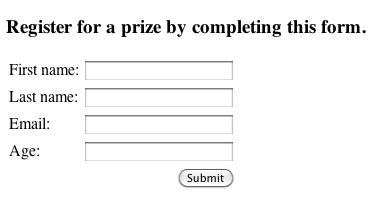Processing Forms
- Introduction
- Forms and a Java model class
- Form structure
- Creating the Action class to handle the form submission
- Adding the view for the result
- Create action mapping in struts.xml
- Create a link to register.jsp
- Run The Example
This tutorial assumes you’ve completed the Coding Struts Actions tutorial and have a working coding-actions project. The example code for this tutorial, form-processing, is available for checkout from the Struts GitHub repository struts-examples.
Introduction
In this tutorial we’ll explore using Struts to do more involved processing of a form submission. We’ll cover how to use a Java model class to store the form input and how to create the Struts form to match up with that model class.
The code provided in this tutorial may be added to the Coding Struts Actions example or you can download this complete example from the Github repository struts-examples.
The Struts user mailing list is an excellent place to get help. If you are having a problem getting the tutorial example applications to work search the Struts mailing list. If you don’t find an answer to your problem, post a question on the mailing list.
Forms and a Java model class
For this tutorial let’s say we need to provide a form that a user may submit to register for a prize drawing. Our business rules state the user must provide his/her first name, last name, email address, and age.
To encapsulate this data, we’ll use a simple Java class that follows the basic Java Bean specifications (public set/get
methods for each instance field). If you’re following along add this class to the package org.apache.struts.register.model
in the Coding Struts Actions example.
Person.java
public class Person {
private String firstName;
private String lastName;
private String email;
private int age;
public String getFirstName() {
return firstName;
}
public void setFirstName(String firstName) {
this.firstName = firstName;
}
public String getLastName() {
return lastName;
}
public void setLastName(String lastName) {
this.lastName = lastName;
}
public String getEmail() {
return email;
}
public void setEmail(String email) {
this.email = email;
}
public int getAge() {
return age;
}
public void setAge(int age) {
this.age = age;
}
public String toString() {
return "First Name: " + getFirstName() + " Last Name: " + getLastName() +
" Email: " + getEmail() + " Age: " + getAge() ;
}
}
Note a few points about the above class. There is a public set/get method for each instance field. The age attribute
is of type integer. We’ve defined a public toString method that returns a String representing the state of the object.
Since we haven’t specified a constructor, Java will provide a default constructor that will set all instance fields to
their null values.
Form structure
To collect the above information we’ll use a Struts form. When creating this form the key concept we need to employ
is to tie each form field to a specific instance field of an object of type Person. Let’s look over the form first and
then discuss some key points. Create a view page named register.jsp (in src/main/webapp)
register.jsp
<%@ taglib prefix="s" uri="/struts-tags" %>
<%@ page language="java" contentType="text/html; charset=UTF-8" pageEncoding="UTF-8"%>
<!DOCTYPE html>
<html>
<head>
<meta http-equiv="Content-Type" content="text/html; charset=UTF-8" />
<title>Register</title>
</head>
<body>
<h3>Register for a prize by completing this form.</h3>
<s:form action="register">
<s:textfield name="personBean.firstName" label="First name" />
<s:textfield name="personBean.lastName" label="Last name" />
<s:textfield name="personBean.email" label ="Email"/>
<s:textfield name="personBean.age" label="Age" />
<s:submit/>
</s:form>
</body>
</html>
Since we are using Struts tags, at the top of the page we need the Struts tag library declaration.
The Struts form will submit to an action named register. We’ll need to define that action in our struts.xml file.
Note the four Struts textfield tags. Each tag has a name value that includes an attribute of the Person class
(e.g. firstName). The name attribute’s value also has a reference to an object called personBean. This object is
of type Person. When we create the Action class that handles this form submission, we’ll have to specify that object
in that Action class and annotate it (see below).
The complete name value, personBean.firstName, instructs Struts to use the input value for that textfield as
the argument to the personBean object’s setFirstName method. So if the user types “Bruce” in the textfield that has
the label “First name”, the personBean’s firstName instance field will have a value of “Bruce”.
Note that we have a Struts textfield for each instance field of the class Person. Remember that Person class’s age
attribute is of type integer. All form field input values are Strings. Struts will automatically convert the String
value (“25”) the user entered for the age form field to 25 when calling the setAge method of object personBean.
Creating the Action class to handle the form submission
When the user clicks on the submit button of the above form, the action “register” and the form data will be sent to the Struts framework. We need an Action class to process this form. If you recall from the tutorial Coding Struts Actions our Action class should extend the Struts ActionSupport class.
Here is the Action class used for this example. Place it in package org.apache.struts.register.action.
Register.java Struts Action Class
package org.apache.struts.register.action;
import org.apache.struts2.ActionSupport;
import org.apache.struts.register.model.Person;
public class Register extends ActionSupport {
private static final long serialVersionUID = 1L;
private Person personBean;
public String execute() throws Exception {
//call Service class to store personBean's state in database
return SUCCESS;
}
@StrutsParameter(depth = 1)
public Person getPersonBean() {
return personBean;
}
public void setPersonBean(Person person) {
personBean = person;
}
}
In the Register class, note that we’ve declared an attribute named personBean of type Person, there are public
getter and setter methods for this object, and the getter is annotated with @StrutsParameter(depth = 1).
In the previous Coding Struts Actions tutorial, we annotated the username setter, which took a
simple String as its parameter type, with @StrutsParameter. In this example, we are using a “Bean” object (sometimes
referred to as a DTO or model object) to encapsulate the form data. When we choose to use a DTO instead of a primitive,
String, or other TypeConverter supported object, we must annotate the getter method instead, and also assign a depth
corresponding to how deep the DTO graph is. In this case, the Person object does not have any further DTOs or
collections within it, so a depth of 1 will suffice.
For more information on these annotations and their security implications, please refer to Security.
The Register class also overrides the execute method. The execute method is the one we will specify in the
struts.xml to be called in response to the register action. In this example, the execute method just returns
the String constant SUCCESS (inherited from the ActionSupport class). But in a real application, within the execute
method we would call upon other classes (Service objects) to perform the business processing of the form, such as storing
the user’s input into a data repository.
The personBean getter of return type Person declared in the Register Action class matches the personBean name we
used in the form’s textfields. When the form is submitted, the Struts framework will inspect the Action class and look
for a getter for personBean. If it returns null and a matching setter exists, it will create that object using the
Person class’s default constructor and set it using the setter. Note that the setter can be omitted if your Action
initialises the field on construction. Then for each form field that has a name value of personBean.someAttribute
(e.g personBean.firstName) it will call the personBean’s public set method for that attribute and pass it the form
field’s value (the user input). This all happens before the execute method occurs.
When Struts runs the execute method of class Register, the personBean object in class Register now has values
for its instance fields that are equal to the values the user entered into the corresponding form fields.
By using a Java model class to encapsulate the data provided by the form we don’t have to have a separate attribute (with public set/get methods) in the Action class (Register) for each form field.
Adding the view for the result
When SUCCESS is returned by the execute method we want to display a simple thank you page that shows the user’s
registration. Add the thankyou.jsp below to src/main/webapp.
thankyou.jsp
<%@ taglib prefix="s" uri="/struts-tags" %>
<%@ page language="java" contentType="text/html; charset=UTF-8" pageEncoding="UTF-8"%>
<!DOCTYPE html>
<html>
<head>
<meta http-equiv="Content-Type" content="text/html; charset=UTF-8" />
<title>Registration Successful</title>
</head>
<body>
<h3>Thank you for registering for a prize.</h3>
<p>Your registration information: <s:property value="personBean" /> </p>
<p><a href="<s:url action='index' />" >Return to home page</a>.</p>
</body>
</html>
If you don’t recall how the Struts property and url tags work consult the Using Struts Tags tutorial.
Create action mapping in struts.xml
To specify the relationship between the form submission page, the Struts Action class, and the success view page
we need to add an action node to struts.xml. Add this action node to struts.xml (src/main/resources) after
the hello action and before the closing package node.
action node for struts.xml
<action name="register" class="org.apache.struts.register.action.Register" method="execute">
<result name="success">/thankyou.jsp</result>
</action>
The above action tells Struts that when the register action is provided to call method execute of class Register.
If that method returns result “success” return to the browser the thankyou.jsp.
Note that we don’t need to tell Struts anything about processing the form. The transfer of the form field input values
to the personBean object will happen automatically provided we’ve followed the convention of naming our form fields
to match personBean.attributeName (e.g. personBean.lastName).
Create a link to register.jsp
So that the user can find the registration page, add this link to index.jsp
Link to register.jsp
<p><a href="register.jsp">Please register</a> for our prize drawing.</p>
Run The Example
If everything is correct, you should be able to run the application (using mvn jetty:run), and open this URL in your
web browser:
http://localhost:8080/form-processing/index.action. On that page
should be a link to register.
Click on that link and you should see the register.jsp page.

Fill out the form and click the submit button. You should then see the thankyou.jsp page.

| Return to Coding Struts Actions | or | onward to Form validation |
